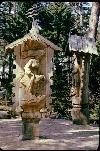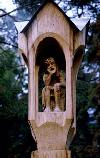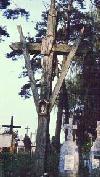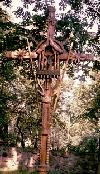







|
SMALL ARCHITECTURE
Small Lithuanian architecture is made up of wayside crosses,
shrines and also other forms of exterior buildings. Its content, form and
function developments are distinct three periods of time - until mid 20th
century, during Soviet occupation and Lithuanian Renaissance. Here is revived
early - origin and maturing time, which as the origin of small architecture,
its sources are not fully researched. These structures are expressions
of Lithuanian national beliefs, world outlook, artistic capabilities. This
was evident to many researchers and according to the opinion of V.Ðukevièius,
even ethnic Lithuanian lands can be defined according to the numbers of
wayside crosses and their artistic variations. Similar style structures
can be found in neighboring Catholic lands, especially Poland, however,
they are not as numerous as in Lithuania.
Most small architecture structures were built in the
19th century - along roads, in villages, at crossroads, at approaches to
towns and town squares, homesteads, even in forests and in cemeteries.
Form, variation of ornamentation, shows off their creators - ordinary,
quick thinking village craftspeople.
Nevertheless it is possible to single out several basic
small folk architectural forms :
-
Cross wise crosses ( Latin cross shape ), various height
( 3 to 8 m. ) structures, often highly ornamented, sometimes with chapels,
of various Christian symbols, sculptures next to the crucifix, which on
crosses and in other small architectural structures is indispensable and
most important. Crosses with two crossings, called St. Benedict's, black
death crosses are rarely built.
-
Wayside shrine is made of a post with a roof, with supports
and a cornice. There can be several roofs, strung on the post, whose top
will be covered with a chiseled metal top - ornamental cross. These small
roofs, especially their cornices and supports are heavily ornamented with
sculptures under them.
-
Shrines on a post or shrine posts. They are of two types.
The first structure type, shrine, is hollowed out like a niche or a vault,
the top of the post is covered with a roof and a forged steel cross. Second
type shrine is firmly set on the post, the roof is also decorated with
a forged cross. Their size, form, roof shape are very diverse. Sometimes
they are of two stories ( two shrines are set on the post ).
-
Shrines on the ground. These are most often repetitive structures
of cemetery shrines, various architectural styles of miniature church forms.
Their interiors are filled with sculptures, sometimes with pictures and
some religious objects. They are of various sizes - from one to three,
sometimes even five meters high. They are erected along roadsides, in cemeteries
and at homesteads.
-
Shrines on trees. They are most limited in form and ornaments,
small, hung in trees along roadsides and even in forests, less often in
homesteads.
In separate ethnographic regions, the above mentioned small
architecture forms are distributed unevenly. Crosswise crosses are planted
throughout Lithuania and predominate in Dzûkija and Suvalkija. Samogitia
is notable for shrines on a post and shrines on the ground. Very ornamental
wayside shrines set on a post are most characteristic to Aukðtaitija.
As mentioned, many small architectural structures differentiate with rich
and varied decorations which are formed with geometric and plantlike ornaments,
and with many archaic elements in the sculptures.
In the first half of the 20th century, fewer crosses
and shrines were built, it is easy to note changes in form and ornamentation,
however, the tradition of building them did not disappear. During Soviet
times many ancient, folk sacral structures were destroyed, some were self
ruined. New structures were legally and publicly inconceivable. A new phenomenon
appeared in the eighties - secular, non religious, small architecture :
ensembles ( Ablinga, "the Road of Èiurlionis", "Witches'Hill", and
others of which were created about 20 ) and single structures. Differing
from ancient small architectural creations, most dominating in them were
sculptural forms, architectural elements which have a more practical than
decorative meaning. However, a true formal connection with tradition is
protected especially when on top of roofs are found forged metal "suns",
very close to ancient cast iron crosses. New structures, called folk monumentalizations,
featured personages - war dead, workers, literature and folklore heroes,
prominent people, Soviet army soldiers. These are totally decorative structures,
decorating parks and children's playgrounds.
Here are four forms which have appeared after the war
years :
-
Round sculpture. This type sculptural compositions dominate
in structures, take up almost the entire vertical trunk of an oak tree
( 3-6 meters in height). It is covered with a roof with a metal "sun" on
top.
-
Reliefs - bas-reliefs. These are subjective compositions
carved in embossed and raised designs, with one or several horizontal bands,
spread out on the round oak tree trunk. The entire structure is usually
covered with a forged steel, decorative top.
-
Classic forms, most often shrines on a post. They are used
as an expressive, decorative accent in space, often filled up with secular
content carvings.
-
Decorative compositions. They are varied in form and purpose,
most often have a practical function ( benches, signs, game mechanisms
).
During recent Renaissance years this sphere's folk creative
works, interlace traditions of cultural legacy and after war, formed creativity
principles. Near abundantly built crosses and shrines, still exist various
secular content structures. Among the crosses, it is possible to single
out, according to remaining photos or memories, whether the structure is
rebuilt or a new one is set up in place of the destroyed piece, repeating
ancient forms.
|





|












